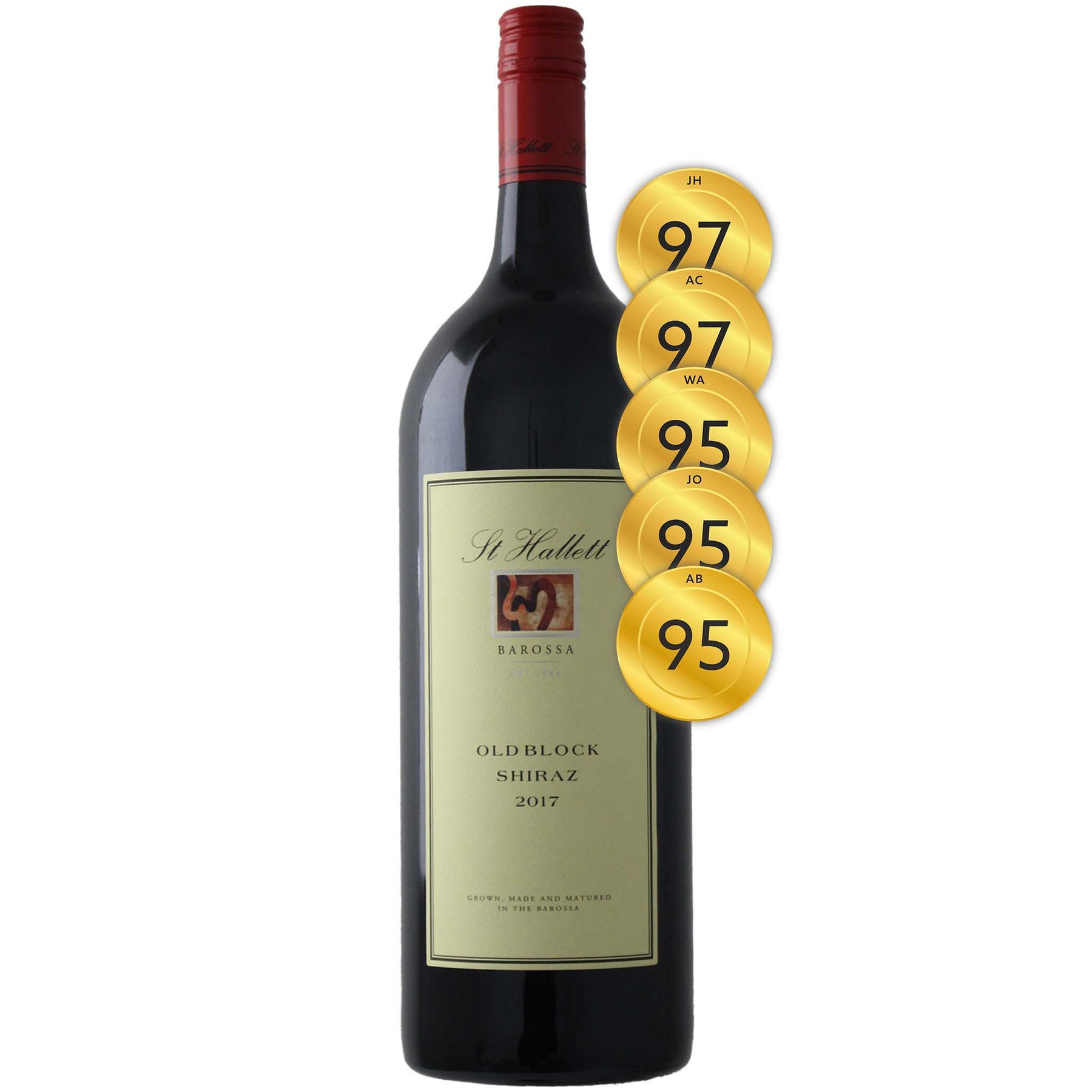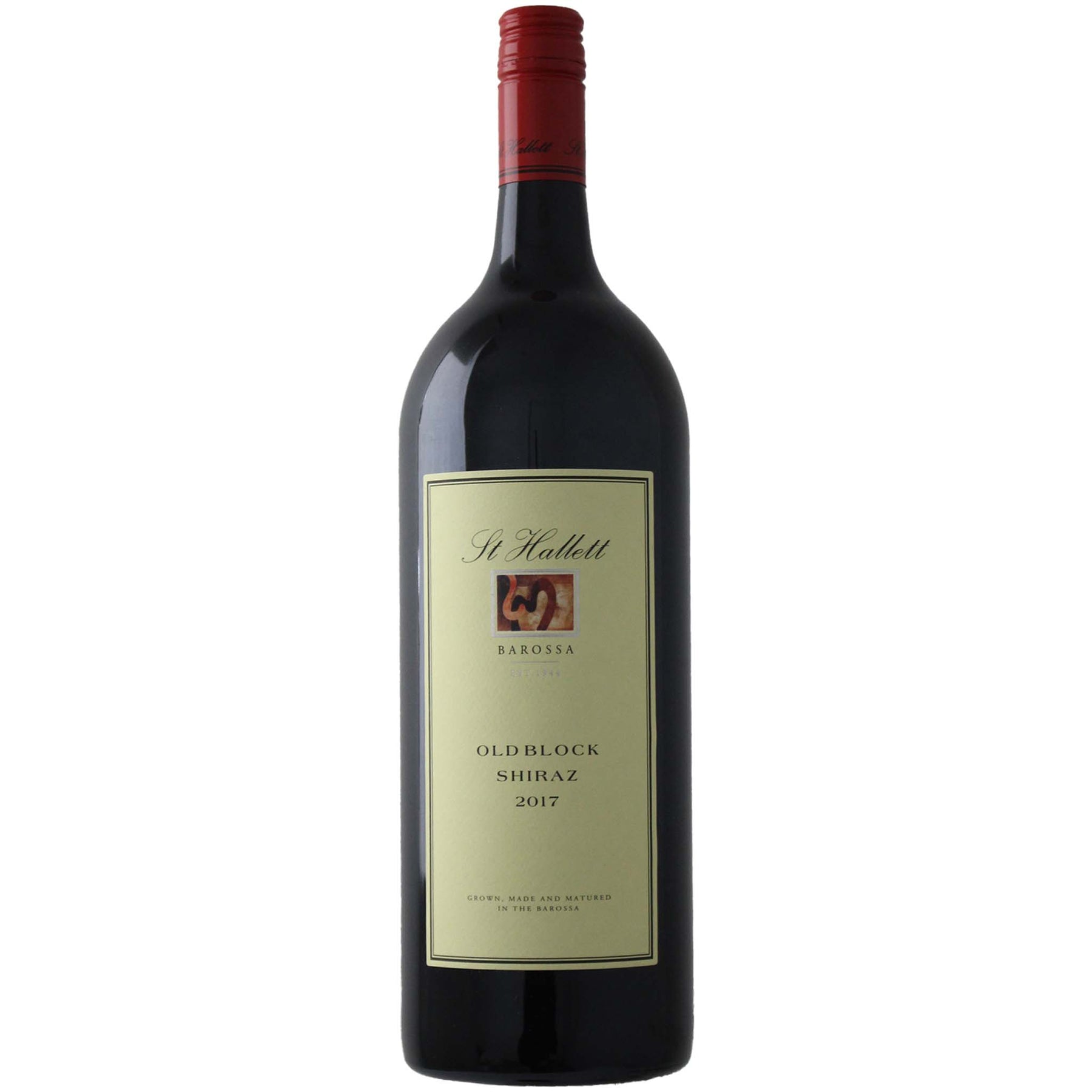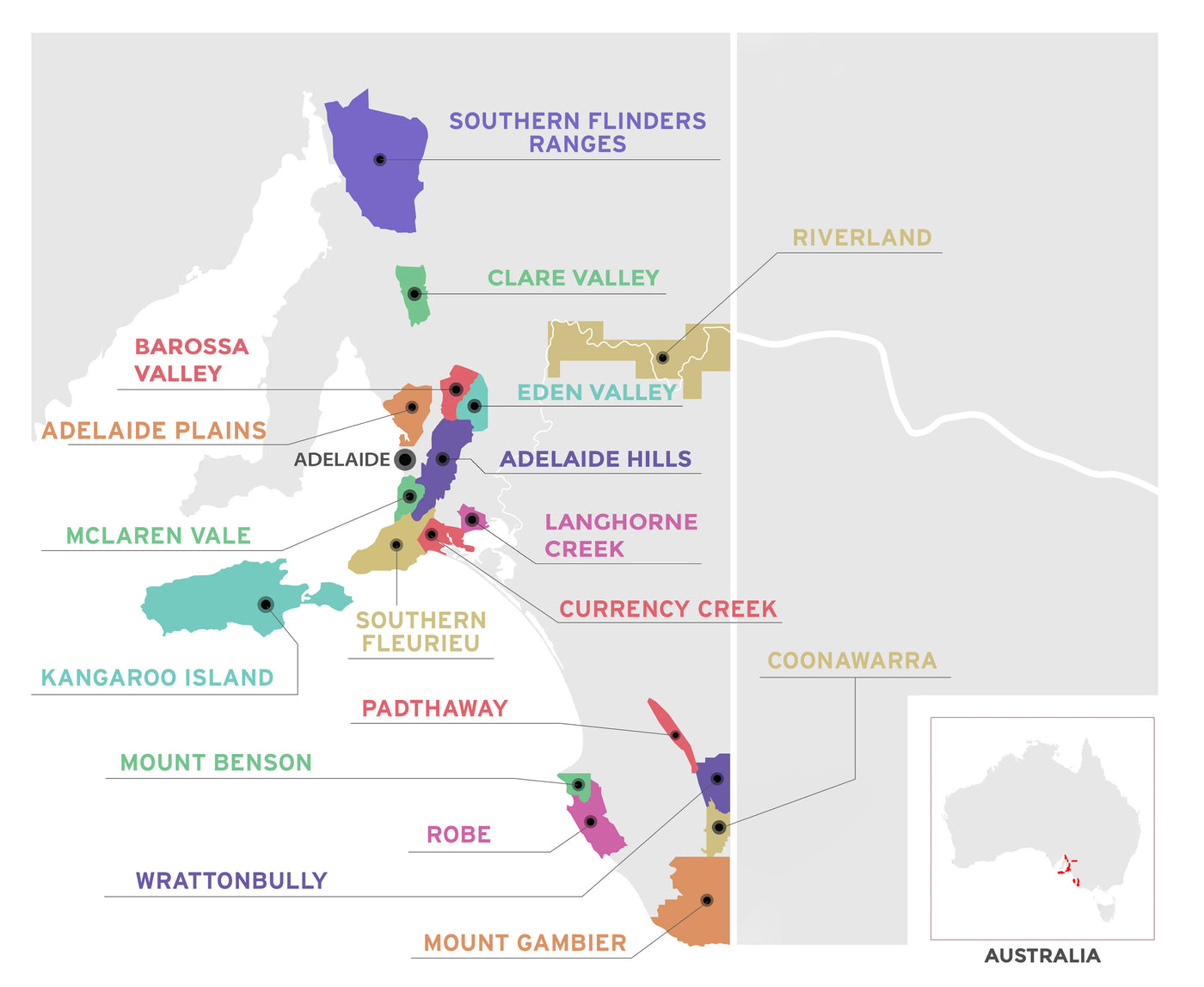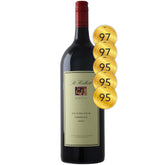

St Hallett Old Block Shiraz 2017 (1500ml)
Style: Red Wine
Variety: Shiraz
Closure: Screwcap
St Hallett Old Block Shiraz 2017 (1500ml)
Warehouse
34 Redland Drive
Vermont VIC 3133
Australia
Critic Score: 97
Alcohol: 14.7%
Size: 1500 ml
Drink by: 2060
This is the flagship of St Hallett's wines and has become one of the great icons of Australian wine. The 2017 Old Block Shiraz is a blend of fruit from the Barossa Valley (51%) and the Eden Valley (49%). The average age of the vines is 96 years old. The Barossa component provides the fundamental core of blackberry fruit, while the higher altitude Eden Valley component adds the cooler climate spicy elements and some savoury texture.
"This is concentrated, set into a medium-bodied (plus) frame, and shows an array of red fruits and exotic spice. It's a cracking wine that manages to hold onto traditional and classical, but it also taps into modernity in the shape of its tannins and its flow of fruit. Super smart." Erin Larkin
Expert reviews
"Medium-deep crimson. Attractive espresso, dark cherry, blackberry aromas with praline/mocha/roasted chestnut notes. Smooth, supple and refined with dark cherry, blackberry, dried plum, red currant fruits, persistent fine graphite-like tannins, inky richness and underlying roasted coffee, mocha, chestnut, hint tobacco leaf notes. Finishes
chocolaty/chewy firm with plenty of mineral length. Multi-layered but medium-powered wine with lovely fruit complexity and integration. A classic Barossa Shiraz showing the enduring hallmarks of extended oak maturation. Will keep for years. Drink: Now – 2038+." Andrew Caillard MW, The Vintage Journal - 97 points
"Elegant and perfumed wine, reflecting the cool vintage to best effect. Black cherry and berry, long and supple in the mouth, with some cedary oak and finely wrought tannins. Always a classy wine, the first vintage put St Hallett on the road to where it is today. Drink by 2041." James Halliday, Halliday Wine Companion - 97 points
"This is an important wine in the St Hallett lineup, and it's a blend of two areas within the Barossa Zone: Barossa Valley (51%) and Eden Valley (49%). The plantings range from 1963 through to the 1850s, and the 2017 Old Block Shiraz is a great example of how old vines cushion the wine from the impact of the vintage. This is concentrated, set into a medium-bodied (plus) frame, and shows an array of red fruits and exotic spice. It's a cracking wine that manages to hold onto traditional and classical, but it also taps into modernity in the shape of its tannins and its flow of fruit. Super smart. Drink: 2022-2037." Erin Larkin, Wine Advocate - 95 points
"Smooth and genuinely elegant, this medium to full-bodied shiraz unfolds a spicy, faintly smoky and confiture-like bouquet of black and red berries, blood plums and chocolate/vanilla oak backed by notes of cola and dried herbs. Supported by fine, chalky tannins, it's measured and evenly paced, delivering smooth fruit and oak before finishing with a savoury, umami-like aspect and a refreshing acidity. Drink 2029-2037+." Jeremy Oliver - 95 points
"Dark and deep in the glass. Aromas of satsuma plum, black cherry, dark chocolate, coffee, cedar and spice. Full-bodied, rich, dark and mouth-filling. Mulberry, boysenberry, mocha, aromatic sweet spice and layered oak. Textured and mouth-coating tannins, bright acidity, plenty of grip and cut. A sleeper. Drink 2021-2036." Aaron Brasher, The Real Review - 95 points
Helen McCarthy

When a young Helen moved with her family from England to Australia in 1988, she had no idea what her future would hold. She had an interest in science, but on her 18th birthday, she was persuaded to enrol in an oenology degree at the University of Adelaide and never looked back. Helen graduated with first class honours in 2000, and has since enjoyed a steady climb to the top of her profession.
On completion of her degree she joined Southcorp Wines and worked at Lindemans, Wynns Coonawarra Estate, Seppelt and Penfolds. In late 2002, she joined Taylors Wines in the Clare Valley. She spent eight years at Taylors, the last six in the coveted role of Senior Winemaker. Less than a decade after she graduated, she was recognised as one of Australia’s brightest winemaking talents, winning two Young Winemaker of the Year awards in 2008. She followed these up with two more in 2013.
In late 2011, the calling of home - Barossa - saw Helen move to Thorn-Clarke Wines as Senior Winemaker. She helped lead a new generation of Barossa winemakers and her 2012 Ron Thorn Shiraz was named 'The Best Shiraz in the World' at the prestigious International Wine and Spirit Competition. Helen particularly loved the region's strong sense of community and commitment to sustainability. Helen's time at Thorn-Clarke ignited a passion for Eden Valley, and in 2015, she took up the position of Chief Winemaker at Mountadam Vineyards. The focus during her time at Mountadam was on lifting the profile of the winery.
In late 2019, a once-in-a-lifetime opportunity arose, and Helen joined St Hallett as Senior Winemaker. This led to her being promoted to the role of Director of Global Winemaking for Vinarchy in 2025, following the merger of Accolade Wines and Pernod Ricard Winemakers. Vinarchy is home to a range of global brands led by Hardys, Campo Viejo and Jacob’s Creek, and domestic brands including St Hallett.
The following interview is taken from https://wineriesofsouthaustralia.com.au/meet-the-winemaker-helen-mccarthy/
When did you realise you wanted to become a winemaker?
It was when I was eighteen and finalising my course choice for university. I had put down pure science degrees until my best friend suggested winemaking. He got one of his wine marketing subject lecturers to call me, and we talked for two hours about the industry, winemaking, and his passion for said industry. He infected me with the wine industry bug and I changed my preferences at the twelfth hour. Luckily, I got in and enrolled on my eighteenth birthday and I haven’t looked back!
Please tell us about your career so far
I have a Bachelor of Agricultural Science (Oenology) with First Class Honours and a Master of Business Administration. When I finished my undergraduate degree I joined Southcorp Wines as a graduate winemaker and spent time at Lindeman’s Wines in Mildura, Wynns in Coonawarra, Seppelt Great Western in the Grampians and Penfolds in the Barossa.
In late 2002, I took a position as winemaker at Taylors Wines in the Clare Valley. The eight-year period that I was at Taylors was a massive growth period, and after two years I was promoted to senior winemaker.
The calling of home – Barossa – was too strong, and I began working for Thorn-Clarke Wines in late 2011 as senior winemaker/manager. The role included managing a vineyard estate of 280-hectares. Working at Thorn-Clarke sparked a passion in me for Eden Valley.
In 2015, I took on the role of chief winemaker at Mountadam Vineyards. The focus during my time at Mountadam was on not only chardonnay but also on lifting the profile of Mountadam’s red wines. I loved being part of a small, tight-knit team of people who were passionate about maintaining such an iconic
and important brand to the Australian wine industry. In late 2019 I was presented with the opportunity of joining St Hallett as senior winemaker and manager.
What do you love most about being a winemaker?
I love the variety in the job – I get to walk around the vineyards, get my hands dirty, and use science and art to produce something. I also get to travel and eat and drink in places that I probably couldn’t [otherwise] afford! What’s not to love?
What is your favourite wine, and what food do you typically pair it with?
My favourite variety is riesling, I love the purity and diversity of style. Typically I’ll drink a glass by itself, but it’s also great with a range of dishes from salad right through to spicy curries.
Is there a specific process you follow when developing a new wine?
My brain is quite creative, but my personality is more structured so the process I follow is to look at what is already on the market (that may be within Australia and also outside Australia). From there, it’s to taste as many different wines as I possibly can, and learn as much about that target style or variety as I can. Then I create a style brief that considers what I’m trying to achieve and what I have at my disposal. This brief includes key descriptors about how the wine should smell, taste and feel. Then it’s about spending lots of time planning how we are going to achieve that brief, doing it, and then blending and finishing the wine off.
Is there any vintage you’re particularly proud of creating? Why?
The 2021 vintage is in my mind, the best one I’ve ever been involved in – everything is just amazing. I’m proud of the wines we’ve created, but we really can’t take the credit. In reality, all the stars aligned!
How does the local climate/soil affect the wine you make?
Local climate and soil has a significant effect on the wines that we make. There is a massive difference between fruit sourced in different areas of the Barossa, or even within the same vineyard. It’s our job to highlight and respect these differences – our aim is not to make everything look the same.
Which of your own varieties do you typically indulge in?
At the moment, I’m enjoying a lot of the 2018 St Hallett Higher Earth Syrah and a new release, which is a new take on what it means to be a Barossa shiraz – 2021 St Hallett Blockhead Shiraz Nouveau.
Where do you see yourself in five years? How do you think your winemaking will evolve during this time?
[In five years] I’m planning to still be making wine at St Hallett – still learning about Barossa shiraz and finessing our approach to making outstanding wines that have a sense of place, and that respect the vineyard they were sourced from.
About the winery

Established in 1944 by the Lindner Family, St Hallett represents the very spirit and soul of winemaking in the Barossa. For most of that time it was owned, or part-owned, by one family, the pioneering Lindners, who arrived in the Barossa from Silesia in 1838. In 2017, St Hallett was acquired by Accolade.
St Hallett sources all grapes from within the Barossa and is synonymous with the region's icon variety, shiraz. From the beginning, St Hallett understood the importance of saving old vines and focusing on varieties that thrive in the Barossa region. Strong long-term relationships with focused and passionate growers give St Hallett access to the Barossa's most prized vineyards, some of which were planted over 100 years ago. Over the years, St Hallett has built up a deep understanding of the rich tapestry of vineyard sites and climates in the Barossa and sources the finest vines and highest-quality parcels of fruit the Barossa can offer.
Old Block Shiraz (using grapes from Lyndoch and Eden Valley) is their flagship wine, supported by Blackwell Shiraz (using grapes from Greenock, Ebenezer and Moppa Hills).


South Australia
South Australian is responsible for more than half the production of all Australian wine. It is home to more than 900 wineries across 18 wine regions. The regions are Adelaide Hills, Adelaide Plains, Barossa Valley, Clare Valley, Coonawarra, Currency Creek, Eden Valley, Kangaroo Island, Langhorne Creek, McLaren Vale, Mount Benson, Mount Gambier, Padthaway, Riverland, Robe, Southern Fleurieu, Southern Flinders Ranges and Wrattonbully.
Many of the well-known names in the South Australian wine industry established their first vineyards in the late 1830s and early 1840s. The first vines in McLaren Vale were planted at Reynella in 1839 and Penfold's established Magill Estate on the outskirts of Adelaide in 1844.
South Australia has a vast diversity in geography and climate which allows the State to be able to produce a range of grape varieties - from cool climate Riesling in the Clare and Eden Vallies to the big, full bodied Shiraz wines of the Barossa Valley and McLaren Vale. Two of Australia's best-known wines, Penfolds Grange and Henschke Hill of Grace, are produced here. There is much to discover in South Australia for the wine lover.

